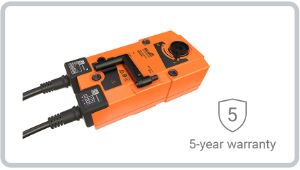Pressure differential system (PDS)

Efficient smoke control, more safety.
Increasing urbanisation is leading to a dense approach to construction, with greater height and depth on a small surface area. Buildings of this type, which are typically high-rises, require new technical solutions that enable safe evacuation in case of fire and support fire-fighting operations. Pressure differential systems ensure smoke-free escape and rescue routes – especially in staircases or fire-fighting lifts – and are becoming increasingly important. They enable the implementation of a so-called protected staircase, which may eliminate the requirement for a second staircase without compromising safety (the relevant local standards and guidelines must be observed). Ideally, this freed-up space could then be used for other purposes and construction costs thereby reduced.
-
Application brochure – Pressure differential systems (pdf - 5.81 MB)
-
Reference – High-rise building Tscharnergut Bern, Switzerland (pdf - 1.87 MB)
Safety without compromise
Comprehensive product range for PDS solutions

Product range
Description of the function of a pressure differential system

Pressure differential system are permanently installed devices that prevent the penetration of smoke through controlled overpressure in the areas to be protected - usually vertical escape and rescue routes (protected staircase) in high-rise buildings. Smoke control in escape and rescue routes is an important requirement for the evacuation of people and firefighting measures by the fire department over a longer period of time. The following criteria play an important role:
- The pressure gradation (pressure +) between the protected and the unprotected area with closed doors
- Maximum door opening force of ≤ 100 N
- Air flow rate of ≥ 1 m/s; ≥ 2 m/s when the doors are open, from the area to be protected via the air release path to the outside
System areas of a PDS

Outside air
The outdoor air is taken directly from the outside and must be protected against the intake of smoke, flammable gases and steam. The outdoor air supply must be monitored by means of duct smoke detectors.
Air distribution
In order to minimise flow or pressure losses in the staircase, outdoor air is blown in through a shaft on several levels (e.g. every third floor) for taller buildings.

Pressure control
The pressure relief damper is a device for the release of excess compressed air from an overpressure area (staircase). This device is usually located at the top of the staircase. In pressure control mode (i.e. when the staircase doors are closed), the excess air should be discharged into the atmosphere via the pressure relief damper. Mechanically or motorised pressure controls are possible.

Air release
Features (such as shafts and facade openings) through which the hot smoke can escape from the accommodation or another area not under pressure from the building. Approved products must be used in the air release (e.g. certified smoke control dampers). Smoke can be released via the shaft in the lobby or via the facade opening, e.g. in the accommodation.
Belimo Experience Center – Safety Lab

Belimo PDS pilot system for testing and demonstration purposes
Pressure differential systems are becoming increasingly important for the safety of modern buildings. Belimo is investing in an internal PDS test environment as part of its preventive fire protection system. This allows new solutions to be realistically tested and demonstrated. Both a system with a pressure relief damper (barometric damper) and a variant with a motorcontrolled pressure relief damper can be demonstrated. We focus on custom motorisation for specific dampers but also on acquiring relevant physical parameters with our sensors. Actual value signals are fed to intelligent controllers, which then regulate and control the damper actuators and the dampers. Training and practical experience are another focal point for different target groups such as public authorities, specialist planners, systemintegrators, investors or maintenance companies. The Belimo development and sales staff also use the test environment as a test facility or for training and further education.
- Customer advantages
Consulting engineers

Planning pressure differential systems is your core competence. You are constantly on the lookout for new, innovative and state-of-the-art solutions. You work with the most modern methods and use data from suppliers / manufacturers for your planning.
- State-of-the-art solutions
- Innovative and future-oriented technologies
- Complete and easily accessible documentation
- Individual product and application consulting
- Reduced planning expenditures
Installers / plant engineers

The installation of pressure differential systems is your trade. To carry out your work, you need the right products at the right time on site. Easy mounting and expert support allow you to meet your tight schedule.
- Short delivery times
- Total solutions from a single source
- Quick and easy installation
- Comprehensive support over the entire life of the product
- Complete and easily accessible documentation
- 5-year warranty
Building owners

Ensuring the operation and maintenance of building safety systems such as pressure differential systems are a constant challenge for you. The focus here is on the highest possible level of building safety with low operating expenditure and low costs.
- Highest level of safety for people and tangible assets in case of fire
- Minimal operating and maintenance costs
- State-of-the-art solutions
- Allows simple regular operational checks
- High reliability and investment security
- Innovative and future-oriented technology
Facility managers / building maintenance

Management, control and operation of buildings and their safety-related technical equipment are part of your daily tasks. You are looking for solutions to guarantee safety in case of fire and to optimise plant operation without compromising safety. You value simple and transparent systems and, if necessary, quick delivery of spare parts and support available at all times.
- Minimal operating and maintenance costs
- High level of robustness and longevity
- Simple regular operational check
- State-of-the-art solutions
- Highest level of safety for people and tangible assets in case of fire
- Remote control for diagnostic purposes






